The golf ball is the only piece of equipment you use on every single shot. For that reason, there’s an argument to be made that the finding the best golf ball is the single most important item in your bag.
Our 2019 golf ball test was an eye-opener for golfers and a reckoning for golf ball manufacturers. It was the largest independent study of its kind and some of the results were shocking. We learned that “soft” is slow, performance differences are more significant than many golfers believe and a poorly made ball can fly significantly offline, even on a perfect swing.
Those findings provided the spark for our Ball Lab initiative and, not surprisingly, golf ball performance testing shot to the top of our most requested list.
Two and a half years later, armed with the knowledge from the first test, we headed out to the desert, reconnected with our robot friend and conducted another ball test featuring the latest urethane models on the market.
Our goal is to help you find the best golf ball for your game.
About the 2021 Golf Ball Test
The 2021 MyGolfSpy ball test was conducted at Scottsdale National Golf Club. Testing took place over five days and included nearly 60 hours of test time. In total, the robot hit just under 4,500 shots. We tested 37 premium balls models (35 of the most popular urethane offerings, refurbished golf balls and Pinnacle range balls).
For this test, we again used a Golf Labs robot. MyGolfSpy designed the test with the help of ball industry experts but the operation of the robot was left to PXG’s highly qualified test engineer.
We tested at three driver speeds and their 8-iron equivalents:
- High: 115 mph driver, 87 mph iron
- Mid: 100 mph driver, 77 mph iron
- Low: 85 mph driver, 65 mph iron
To try to quantify greenside spin, we conducted a wedge test to a distance of approximately 55 yards.
In each scenario, the goal was to replicate as best as we could the launch conditions for golfers within the target range.
Here’s a breakdown of the clubs used for the test:
- Driver – Fast: PXG 0811X GEN4 9° with X-stiff shaft
- Driver – Mid: PXG 0811X GEN4 9° with stiff shaft
- Driver – Low: PXG 0811X GEN4 10.5° with regular shaft
PXG 0311P GEN4 irons and a 56-degree 0311T Sugar Daddy wedge were also used.
To capture the full flight of the golf ball, including the impact of dimples/golf ball aerodynamics on the full flight of the ball, the published data was collected using a Trackman launch monitor. A Foresight GCQuad was run in parallel for comparison purposes and to confirm target lines.
Golf Ball Models Tested
Key Findings
1. Soft is Slow, But …
As we found during our 2019 Golf Ball Test, there is an absolute correlation between compression and ball speed but there are conditions under which softer balls can keep up with firmer balls. For slower players (sub-85 mph), the speed differences are so small that there’s a case to be made for not worrying about it. Among mid to high swing players, those who fall in the high spin category (ballpark 2,800 rpm or more with a driver), lower spin can compensate for the speed lost to lower compression.
Notably, as speed declines, particularly with iron shots, low-compression balls can be a touch faster than firmer ones. Soft is still slow but, under those conditions, it’s the comparably softer covers and mantles of high compression balls that explain the speed differences.
With this in mind, it’s certainly possible that a soft ball could be right for you but also consider that …
2. Soft Doesn’t Spin
While there is not an absolute correlation between compression and spin, the same design principles that make a ball soft invariably lead to a ball that’s lower spinning.
It’s telling that at all three speeds off both driver and irons and with the wedge, the lowest spinning balls were low-compression offerings.
If you’re looking for a bit straighter flight with the driver or to cut spin out of your iron game, soft can work. If you’re looking for more spin on approach shots, it won’t.
3. If It Spins Off The Driver, It Spins Off The Wedge
While ball manufacturers often differentiate between driver and iron/wedge spin, the reality is that, if a ball spins of a driver, it’s going to spin off irons and full (and even partial) wedge shots, too.
For this year’s test, we switched from a 7-iron to an 8-iron and moved our wedge distance to 55 yards. Our hope was that with the higher-lofted clubs and shorter wedge shots, we’d see greater spin differentiation through the bag.
We didn’t.
While there is some movement in the middle of the table, the highest-spinning balls off the driver were consistently the highest-spinning off irons and even with the shorter wedge shots.
The notable exception was the ionomer-covered Pinnacle Practice ball we added to the test. It was the highest spinning ball on iron shots but the lowest on the wedge. This suggests there is a point where the cover has a more significant impact on spin performance but it’s closer to the green than you probably think.
4. Forget About Launch Angle, Trajectory is The Thing
Nearly every box of balls provides some description of the launch characteristics of the balls. Low, mid and high are what golfers understand and expect but, as with many things in golf, those descriptions are grossly over-simplified.
Across the test, we found very little difference in launch angle, especially off the driver. However, when other aspects of trajectory are considered—things like how high the ball flew, how far downrange it reached its peak height and how steeply (or shallow) it fell back to the ground—significant ball flight differences emerge.
The point is that a golf ball can fly any number of ways that defy the limitations of simple descriptions like “low”, “mid” and “high” so, when looking for the right ball, it’s important to consider the full flight of the ball.
We’ll be taking a closer look at trajectory in a future post.
5. For Many, The Best Answers Are In The Middle
Throughout this report, we’ve highlighted some of the fastest and longest golf balls as well as those at the extreme high and low end of the spin scales. As golfers, that’s the info we naturally gravitate to, but there’s a reason some of the most popular balls can be found in the middle of the chart. While some golfers can benefit from the extremes, especially when it comes to spin, for most golfers the best options will be somewhere in between.
6. Golf Ball Models Are Significantly Different
We know many golfers believe all golf balls perform basically the same but few ideas in golf are more detached from reality.
Our data reveals that, while there are similarities to be found between any two golf balls, across the entire pool there are significant differences in key metrics like ball speed, trajectory (the combination launch angle, height and descent angle) and spin.
While some balls like the Kirkland Performance+ and Mizuno RB Tour X are unquestionably a better fit for a niche segment of golfers, that doesn’t mean they’re inherently bad. As with your driver and irons, golfers should look for a ball that provides the optimum combination of ball speed, trajectory and spin.
HIGH SWING SPEED RESULTS
Our Top Recommendations for High Swing Speed Golfers
Low Spin – Snell MTB-X, Titleist Pro V1x Left Dash, Vice Pro Plus
Higher Spin – Callaway Chrome Soft X, Titleist Pro V1x, Wilson Staff Model
Balanced Performance – Snell MTB Black, TaylorMade TP5x, Titleist Pro V1
High Swing Speed Driver
Robot Averages
- Club Speed: 115 mph
- Ball speed: 167.52
- Launch Angle: 13.70
- Spin: 2,927
- Carry: 298.85
- Total: 319.82
Total Distance
Observations (Distance Off The Tee):
- While the Titleist Pro V1x Left Dash was the longest ball and the best ball for distance, the Top 10 shows a mix of high-, mid- and low-compression offerings.
- The lower-compression, low-spinning Titleist Tour Speed was surprisingly long as were other low-compression balls like the Bridgestone Tour B RX and Callaway Chrome Soft.
- For golfers who produce 2,800 rpm or more spin with the driver, the presence of these softer balls near the top of the distance chart suggests that low spin properties of low-compression balls can help offset the significantly lower ball speed for high spin golfers.
Top 10 Fastest
Observations:
- At driver speeds, the firmest balls were the fastest which suggests the greatest potential for distance for most golfers in the 115 mph range.
- The absence of the 100-compression Callaway Chrome Soft X LS from the top of this group is perhaps surprising, though the higher-spinning Chrome Soft X made the list.
Driver Spin
Observations:
- The Kirkland Performance+ V2.0 was the spinniest ball on 115 mph driver shots (and just about everywhere else).
- From our previous test, we expected the Mizuno RB Tour X to be one of the spinner offerings but the higher spin rates of the TaylorMade TP5 caught us by surprise.
- With the exception of the 83-compression MG C4, the lowest spinning balls are all sub-75 compression offerings.
High Swing Speed Iron
Robot Averages
- Club Speed: 87 mph
- Ball speed: 122 mph
- Launch Angle: 20.16
- Spin: 6,381
- Carry: 185.64
- Total: 197.54
Total Distance
Observations:
- The Top 10 for distance includes a mix of low and mid spin.
- At these speeds, trajectory and spin properties play a more significant role in total distance.
Top 10 Fastest
Observations:
- As we slow to iron speeds, high-compression balls lose their speed advantage.
- The fastest balls include a mix of high-, mid- and low-compression offerings.
- With the core being less of a factor, the outer layers of the ball have a greater influence on speed.
Iron Spin
Observations:
- As we’ve noted, spin properties are consistent throughout the bag.
- The balls that were high spinning off the driver (most notably the Kirkland Performance+ and Mizuno RB Tour X) are also spinny off the irons.
- Low compression means lower spin so we’d expect to see five low-compression offerings produce the lowest spin rates.
MID SWING SPEED RESULTS
Our Top Recommendations for Mid Swing Speed Golfers
Low Spin – Bridgestone Tour B X, Srixon Z-Star XV, Titleist Pro V1x Left Dash
Higher Spin – TaylorMade TP5, Titleist Pro V1x, Wilson Staff Model
Balanced Performance – Bridgestone Tour B X, Snell MTB Black, Titleist Pro V1
Mid Swing Speed Driver
Robot Averages
- Club Speed: 100 mph
- Ball speed: 147 mph
- Launch Angle: 12.96
- Spin: 2,422
- Carry: 247.90
- Total: 277.13
Total Distance
Observations:
- Again, our Top 10 for distance covers a range of compressions.
- The absence of the Titleist Pro V1x Left Dash from the Top 10 is a bit of a surprise.
- Firmer offerings like the Maxfli Tour CG and Callaway Chrome Soft X achieve distance through longer carry while softer offerings like the TaylorMade Tour Response and Titleist Tour Speed rely on additional roll (due to lower spin) to maximize distance.
Top 10 Fastest
Observations:
- The firmest balls are the fastest balls as the top 10 is filled with 95+ compression offerings.
- Notably, the Top 10 is a mix of high and low to mid offerings, suggesting little direct correlation between speed and spin.
Driver Spin
Observations:
- The Kirkland Performance+ and the Mizuno RB Tour X are again the spinniest balls off the driver.
- The low-spin end of the chart is again filled with low and mid to low compression offerings (we measured Z-Star and Vero X1 at 81 compression).
Mid Swing Speed Iron
Robot Averages
- Club Speed: 77 mph
- Ball speed: 108 mph
- Launch Angle: 20.89
- Spin: 6,052
- Carry Yards: 158.69
- Total Yards: 173.54
Total Distance
Observations:
- The longest balls at mid-iron speeds are, by and large, lower-compression models.
- The distance comes with reduced spin and shallower descent angles, suggesting stopping power could be an issue for some.
- The only high-compression ball in the Top 10 is the Snell MTB-X at 96 compression.
Top 10 Fastest
Observations:
- The firmest balls in the test have disappeared from the top of the speed chart.
- At 100 mph-equivalent iron speeds, the fastest balls are a mix of high- and low-compression models.
- This suggests that, under these conditions, golfers may no longer be fully compressing the core.
Iron Spin
Observations:
- Spin is spin and it’s consistent throughout the bag so the top and bottom five should look familiar.
- The extreme spin of the Pinnacle Range balls is a great example of why they shouldn’t be used in a fitting environment.
SLOW SWING SPEED RESULTS
Our Top Recommendations for Slower Swing Speed Golfers
Low Spin – Bridgestone Tour B RX, TaylorMade Tour Response, Titleist AVX
Higher Spin – Callaway Chrome Soft X, Titleist Pro V1x, Wilson Staff Model
Balanced Performance – Bridgestone Tour B XS, TaylorMade TP5x, Titleist Pro V1
Slow Swing Speed Driver
Robot Averages
- Club Speed: 85 mph
- Ball speed: 126 mph
- Launch Angle: 13.85
- Spin: 2,782
- Carry: 197.44
- Total: 230.78
Driver Distance
Observations:
- With exception of the Titleist AVX and Tour Speed, the longest balls for this group were largely above 85 compression.
- Golfers in this swing speed range often benefit from higher launch with more spin so low-compression balls are not always the best option.
Top 10 Fastest
- Even at relatively slow driver speeds, firmer balls are fast with the majority being above 95 compression.
- The Wilson Staff Model (and Staff Model R), Titleist Pro V1x Left Dash and Srixon Z-Star were in the Top 10 for all three swing speeds.
Driver Spin
Observations:
- The list is, by now familiar. The Kirkland Performance+, Mizuno RB Tour X and TaylorMade TP5 again hit the board.
- The high end of the chart is comprised entirely of higher compression models.
- Low-compression offerings dominate the low-spin end of the chart with the TaylorMade Tour Response being the lowest spinning ball in this portion of the test.
Slow Swing Speed Iron
Robot Averages
- Club Speed: 65 mph
- Ball speed: 92 mph
- Launch Angle: 21.09
- Spin: 5,577
- Carry: 123.81
- Total: 140.93
Total Distance
Observations:
- At our lowest speed, the longest balls are almost all low-compression offerings.
- The notable exception is the Snell MTB-X.
- While the distance is intriguing, the low-compression offerings fly only moderately higher but spin significantly less than mid- and high-compression models.
Top 10 Fastest
Observations:
- Across the entire table (not just the Top 10), there’s less than a 2 mph difference between the fastest and slowest balls.
- The speed leaders are lower-compression offerings with firmer cover and mantle layers.
Iron Spin
Observations:
- For slower swing speed players, higher spin on iron shots is often desirable so, while low-compression balls can provide more distance, the low-spin properties may not be ideal.
- While we think the Kirkland is too spinny for most, the presence of the Wilson Staff Model, Mizuno RB Tour X and Titleist Pro V1x on this list suggests that lower swing speed players shouldn’t rule out firmer balls.
WEDGE – 55 Yard Shot
Robot Averages
- Club Speed: 50 mph
- Ball speed: 56 mph
- Launch Angle: 28.28
- Spin: 7,270
Wedge Spin
Observations:
- Balls that we would classify as spinny off the driver and irons also produced high spin rates on 55-yard wedge shots.
- The lowest wedge spin was found among the low-compression offerings.
- Across the entire test, spin rates varied by more than 1,300 rpm.
- While the Pinnancle Range balls were among the spinniest off irons, it’s the one ball that showed a significant decrease in spin at 55 yards.
- This is almost certainly due to its thicker ionomer cover.
Ball Speed Versus Compression
We’ve discussed that there is a strong correlation between ball speed and compression (the firmness of a golf ball). When the collision between club and ball occurs at high speed as it does with a driver, a softer ball is a slower ball.
What you may find interesting is that, as the speed of the collision decreases as it does for irons (especially for slow to moderate speed players) and on wedge shots, the outer layers of the ball play a more prominent role in the speed equation. As those outer layers tend to be firmer for lower-compression balls, they can actually be a bit faster off irons and wedges because the part of the ball being struck is firmer.
The chart below details the relationship between compression and ball speed for each condition under which we tested. Use the provided filters to move between club and speed options or filter to see only the balls you want to see.
Observations:
- At all three driver speeds tested, the highest-compression golf balls (Titleist Pro V1x Left Dash and Wilson Staff Model) produced the fastest ball speeds. This suggests slower swing speed golfers are still able to compress the core with a driver.
- The notable exception is the Reload (refinished) Pro V1. Despite an average compression rating that’s closer to Pro V1x than a real Pro V1, it produced ball speeds at or below what we saw from the softest balls in the test.
- At iron speeds where the collision is slower and less efficient (lower smash factors), even at higher speeds a number of low-compression offerings, like the Vice Pro Soft and OnCore Elixr, match and even better the ball speed of the high-compression balls.
- As you would expect, ball speed differences aren’t nearly as significant as they are with the driver.
- As iron speeds drop into the mid-range of our test, the low-compression balls are faster. Soft is still slow but context matters. The softer outer layers of the high-compression (firm core) golf balls are responsible for a modest speed deficit while the lower-compression balls gain speed because of the firmer covers and mantles.
- At our slow iron speeds, low-compression balls like the Elixr, Pro Soft and Tour B RXS lead in speed while firmer balls like the Chrome Soft X LS and TaylorMade TP5x fall to the opposite end of the chart, though they’re only about 1.5 mph slower.
- On 55-yard wedge shots, the firmest balls are almost invariably slower (again, due to the comparably softer outer layers). You’re probably not going to buy a golf ball based on an additional 1 mph on a partial wedge shot but it’s interesting to see a complete picture of the correlation between compression and speed.
“Soft” Ball Recommendations
Low compression isn’t for everyone and, frankly, we believe they’re not the best fit for most golfers. That said, we understand many of you prefer the feel of a soft golf ball. With that in mind, here are our top picks in the low-compression space:
- Bridgestone Tour B RX – Arguably the best all-around performer in the low-compression category
- Callaway Chrome Soft – A big step up in consistency from the previous model
- OnCore ELIXR – A solid performer at a more affordable price
Test Notes
This section details some additional observations made during the 2021 Golf Ball Test.
Offline Balls Given what transpired with our first ball test—specifically balls flying significantly offline and, in one case, even duck-hooking—we were on constant watch for the big miss.
While there was a handful of shots that raised an eyebrow or two (and those balls went back to our Ball Lab for closer examination), generally speaking, balls were less squirrelly this time around.
Durability In our first test, we had two models scuff severely during the wedge portion of our test. This year, we didn’t note any significant durability issues, nothing more than a modest paint scuff.
Callaway Chrome Soft The “ball that changed the ball” was closely watched during this year’s test. Suffice it to say performance was significantly better this time around. We found no notable issues with the standard model which held up well alongside the other low-compression offerings.
Kirkland Performance+ V2 Always a curiosity because of its price point, the Kirkland Performance+ V2 was surprisingly consistent but easily qualifies as the spiniest ball in the test. It’s an inexpensive though decidedly niche offering. Golfers often want more spin but probably not this much.
Pinnacle Practice Balls In the driver portion of the test, the range balls performed admirably enough that we started to wonder if we were wrong about their usability in a fitting scenario. Their performance on irons (excessively spinny) and wedges (frighteningly not spinny) provided further evidence that you shouldn’t be hitting range balls during a fitting (or anywhere else … other than the range).
Titleist Tour Speed Often left out of the discussion, Titleist’s other ball was one of the big surprises of the test. The low-spin, low-ish-compression offering was consistently among the longest. Like most other low-compression balls, the reasonably extreme low-spin properties mean it won’t be for everyone.
Reload Pro V1 (Refinished) We were shocked by the poor condition and lackluster performance of the refurbished golf balls we purchased for this test. We’re going to run them through Ball Lab and can’t wait to share the results.
TaylorMade TP5 While we expected the TP5x would be a tick slower this time around given its lower compression, it was the spin of the TP5 that caught us by surprise. Across the board, it’s one of the spiniest balls within its compression range. Not only is it the higher spinning of TaylorMade’s two TP5 offerings, the spin profile is closer to what we find in many competitors’ “X” balls.
Value Golf Balls - Top Picks
For golfers on a budget, these are our recommendations:
- Snell MTB Black and MTB-X - $33.99
- Maxfli Tour CG - $34.99
- OnCore ELIXR - $29.99
Data
The chart below details the key metrics collected during our 2021 ball test. Use the provided filters to move between club and speed options or filter to see only the balls you want to see.
RAQ (Reader Asked Questions)
Q: What’s the right compression for my swing speed?
A: There isn’t one.
Just like your golf clubs, the key ball fitting variables are ball speed, trajectory (launch, height, descent) and spin.
Did I say compression or feel? No. Sure didn’t.
While there are some near absolutes related to compression (for example, softer balls are slower off longer clubs and lower spinning across the board), despite some of the industry’s best efforts to convince you otherwise, compression (which is closely correlated with feel) is not a fitting variable.
Speed, trajectory and spin determine the best performing ball for any individual golfer. So while many believe high compression is for fast swingers and low compression is for slower ones, the truth is that some high-speed golfers can benefit from the low spin properties of low-compression balls while some slow swinging golfers will benefit from the higher trajectory and added spin offered by some higher-compression offerings.
Q: Does handicap matter when choosing a golf ball?
A: The short answer is no. In simple terms, handicap isn’t a measure of your swing properties. It’s a measure of your ability and consistency. Just as with low-handicap golfers, higher handicaps come in all swing types and the same fitting rules apply.
There is the practical matter of cost. If you’re losing more than a couple of balls a round, it probably doesn’t make sense to spend $45 on a dozen balls. While used balls are an option, we highly recommend avoiding refurbished.
Q: Does temperature change the results of the test?
A: It’s a fact that golf balls fly farther when it’s hot and humid so those are the days when you can expect more carry and more distance. While we did experience some changing conditions, we took measures to minimize the impact of environmental factors on our results.
Q: Should I always play one ball (model) per round?
Our recommendation is to play 100 percent of your shots with the same ball (model). Given the variation between models, it only makes sense to minimize every variable you possibly can.
Q: How does water affect my shots?
A: When water gets on the ball, it reduces friction. The result is that a wet ball will launch higher with less spin than when it’s dry. Matte-finish golf balls are less efficient at repelling water so, relative to a glossy finish, they’ll launch higher still and spin even less.
Q: How do I find the right golf ball for my game?
A: In a perfect world, knowledgeable ball fitters would be as prevalent as club fitters. If you’re lucky enough to have a ball fitter near you, take advantage. If not, here are our recommendations.
Finding the right ball is a process so start with a few you think might work. If you’ve got a launch monitor, use it to trim the list. If you don’t have access to a launch monitor, our data should help you narrow the field. Test on the course and side by side. For the best comparison, don’t test more than two balls at a time.
The conventional wisdom is to start around the green and work backward. The idea here is to see how the ball performs on relatively short shots (partial wedges). From there, move to your irons. That’s where the biggest differences are and where you’re most likely to notice them.
Chances are you have an adjustable driver so once you’ve found the ball the performs best through the rest of the bag, take advantage of the driver’s adjustability and tune it to fit the ball.
Q: If I swing X, will my results be the same as the robot’s?
A: For the swing speed closest to yours, the speed, launch and spin relationships between balls should translate reasonably well. The fastest balls will be fast. The spiniest balls will still be spinny. How those factors come together in the total distance equation depends on other factors in your swing (attack angle, loft and impact).
Q: If the cover of my ball is damaged, will it affect performance?
A: A little bit of missing paint won’t have any impact on ball flight but if the cover itself is damaged, even if it’s just a little scuff, it’s probably best to replace the ball. We did some scuff testing during this test and will be sharing the results later.
Q: Do the pros play the same golf ball I buy off the shelf?
A: For the most part, yes. While balls played on the PGA TOUR often pass through additional checks to ensure they’re conforming, nobody is sitting on a secret stash of high-performance Tour-only balls. Ball manufacturers want their Tour staff playing the retail ball and that’s mostly what happens. That said, nearly every manufacturer has a couple of secret menu offerings. These are typical niche balls that won’t be a good fit for the majority of golfers.
Q: Who provided the balls for the test?
A: MyGolfSpy purchased at retail nearly all of the balls used in this test. Due to COVID-related inventory issues, Snell and Inesis balls were provided by the manufacturer.



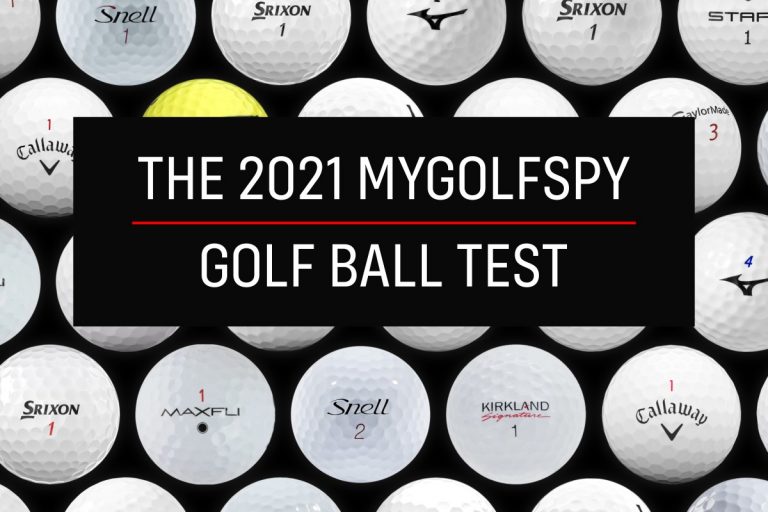
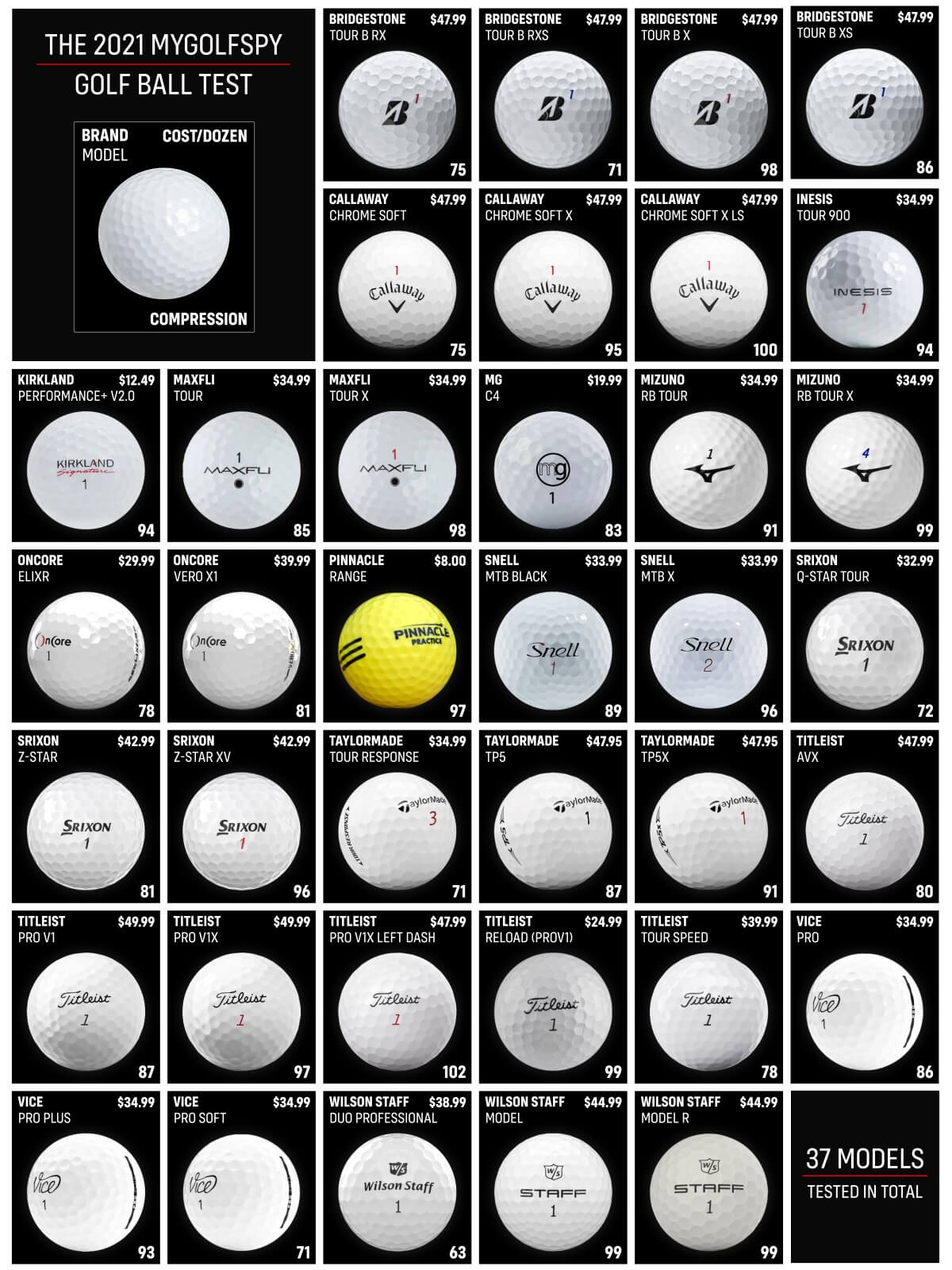
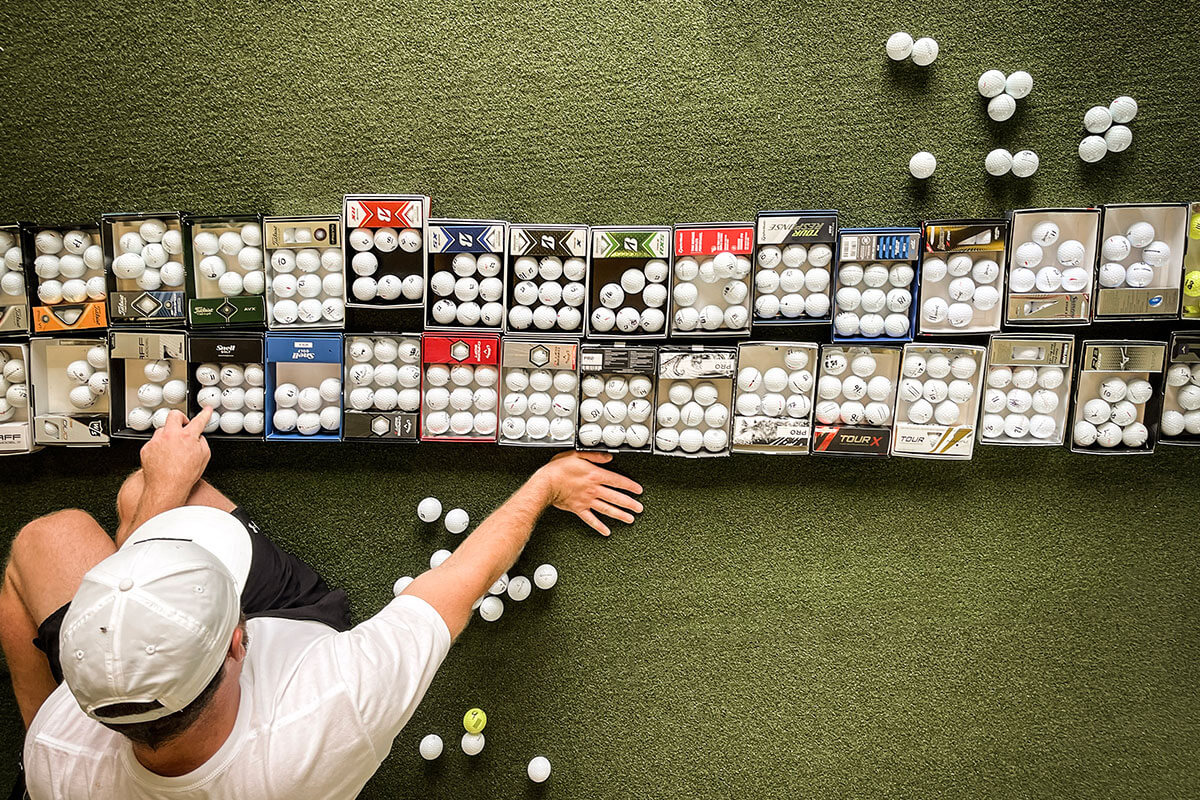














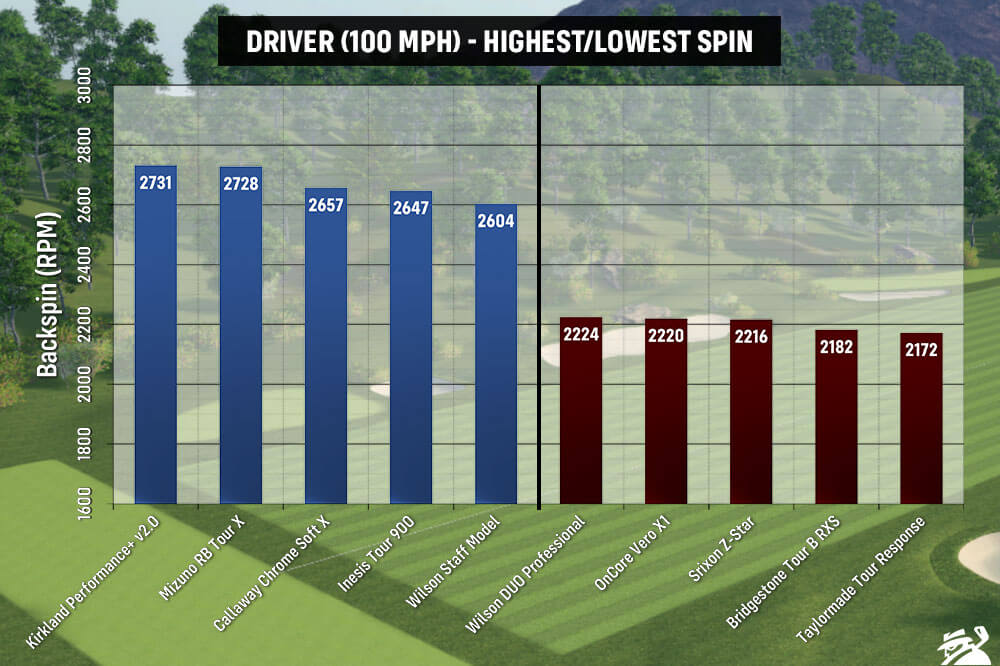




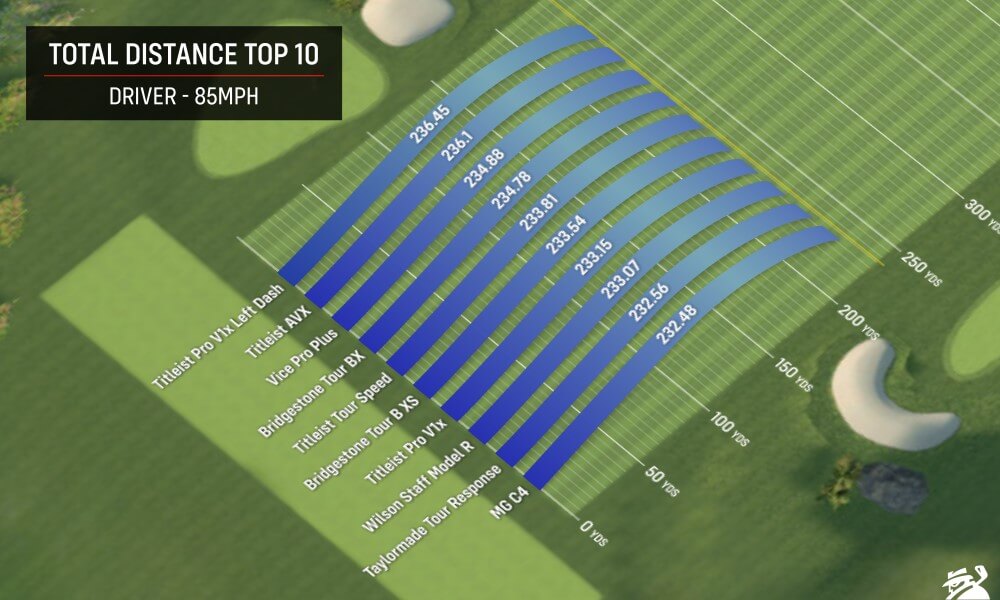


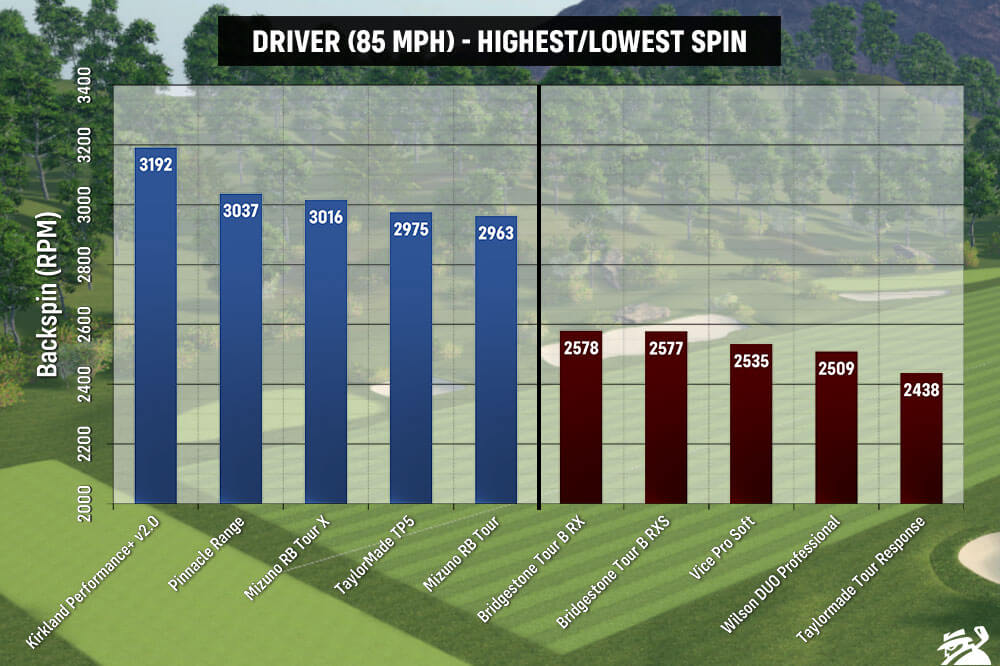
















Mary
1 year ago
Thanks for putting this testing online! In the future, would you consider testing a 70 mph swing speed for driver? Golfers come in all ages and the elderly swing speeds do not seem to be represented in the testing. We all grow old and slow down.